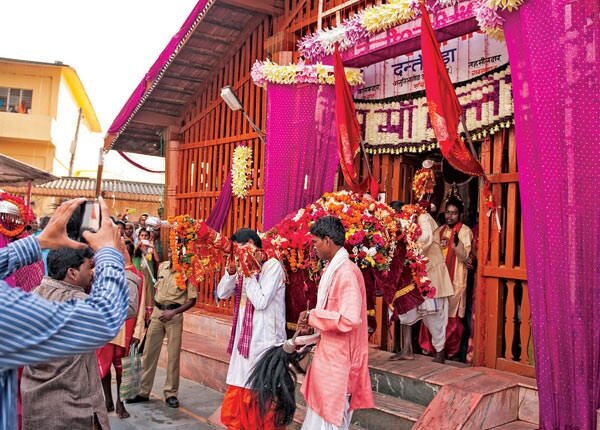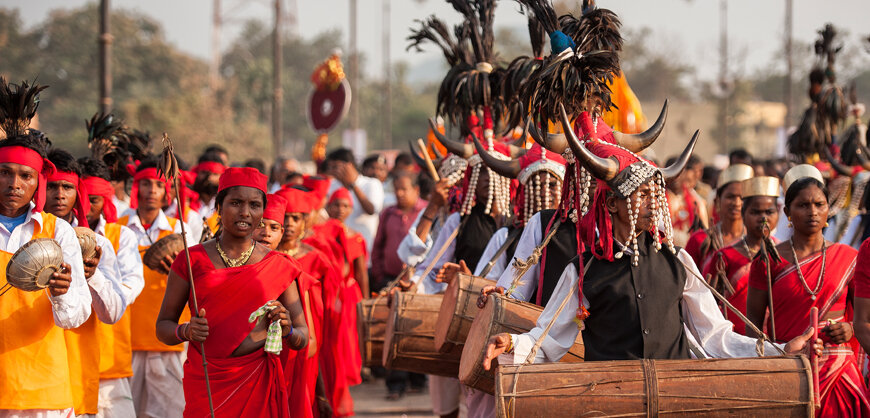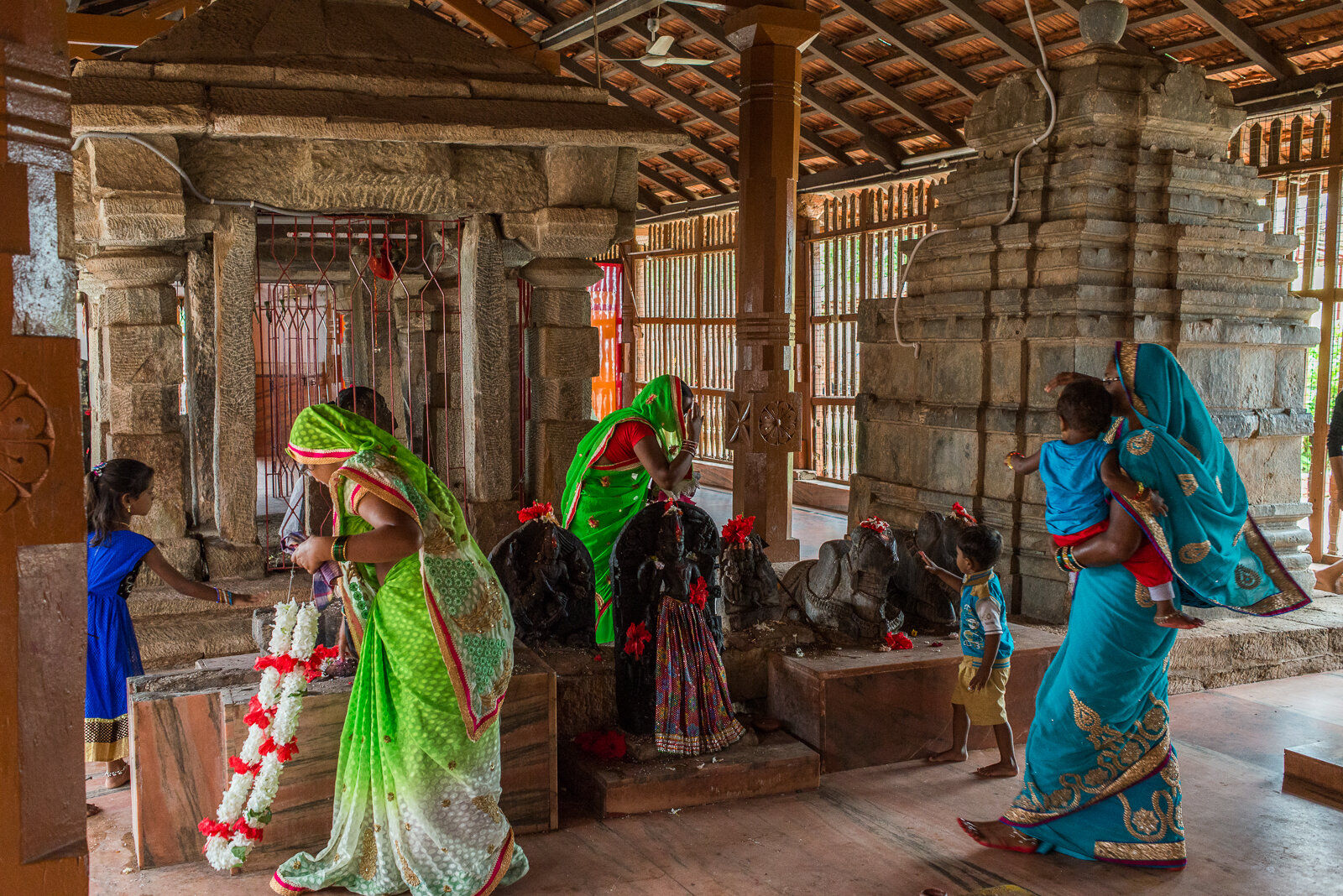Rishi Yajnavalkya and Gargi Vachaknavi, the Brahmavadini, debating in King Janaka’s court.
Image: BAPS
Once the ancient Rajarshi (Philosopher King) Janaka conducted a Yagya (Yajna), at the end of which, all the scholars and philosophers who had assembled to attend the Yagya and exchange ideas, started a discussion on the nature of Brahman. Several great Rishis and Brahmajnanis like Aswala, Bhujyu, Usasta Pandita, Yajnavalkya, Kaholaka, Gargi, Uddhalaka and Sakalya were present in the court. Rishi Yajnavalkya defeated many great philosophers in argument. Then Gargi, the Brahmavadini, rose and challenged him. She confronted him with existential questions about the ontology of the universe. When she continued questioning disregarding the proper method of inquiry into the nature of the deity [1], Yajnavalkya warned her: "You are questioning about a deity that should not be reasoned about, but known only through its special means of approach, the scriptures. Therefore do not, O Gārgī, push your inquiry too far unless you wish to die." Upon hearing this, Gargi Vacaknavi fell silent. The third chapter of Brihadaranyaka Upanishad further explains the eventful debate in the court of King Janaka. Gargi, a learned Brahmavadini, fell silent because she realised the greatness of Rishi Yajnavalkya, and from there on merely tried to learn from him about the Supreme Reality instead of trying to challenge him or examining his knowledge. On the other hand, Sakalya, who arrogantly kept questioning the nature of Brahma, despite Yajnavalkya’s warnings, encountered a tragic and bizarre death, when his head fell off.
Gargi was warned by Yajnavalkya about what shall happen, and being a wise woman, she took cognisance of the warning while Sakalya did not pay heed and ended up paying the price. However, the self-professed “subaltern” academia interprets this incident as an example of Brahminical patriarchy and try to portray the advice of Yajnavalkya to Gargi Vacaknavi as a threat. Mainstream historians and Indologists are reluctant to acknowledge that women sharing deep philosophical debates along with men in great conferences was common in Bharat. Instead, the academia portrays Gargi as an exception, a revolutionary who "embarrassed" Sage Yajnavalkya with daring questions. In order to paint a faux-gender conflict, they cleverly refrain from mentioning what happened to Sakalya. Independent India’s mainstream academia, especially “subaltern” studies, are proudly continuing the legacy of the colonial-era “historians” in misinterpreting and maligning the status of women in Hinduism, the worst victim of which has been the Goddess worship system, or the Shakta sampradaya, because it stands as the biggest obstacle in their artificial gender-conflict story. In this essay, we will show that the relentless misinterpretation campaign, started by the imperialist and colonialists, and continued by independent India’s “academia” can be directly held responsible for the Judeo-Christian morality that dominates our judicial system, which leads to verdicts like the recent HC verdict banning Mrigabali for Maa Tripurasundari, the Mother goddess of Tripura, in the North-Eastern region of India.
shakti as Kuladevi, a proud tradition across india
Shakti worship system, once prevailed across ancient Bharat , through centres of Shakti worship, known as Shaktipeethas. Shaktipeethas are the places where Sati Devi's body parts are believed to have fallen in Satya Yuga. As a result of Islamic invasions in the medieval times, colonial laws, reforms, and partition of India, free practice of Shakti worship has been weakened in many of these historical centers of Goddess worship in India, Bangladesh, Pakistan, Tibet and Nepal. While several centres of Goddess worship physically fell before the brutality of Islamic marauders, the warrior spirit of various Hindu communities posed relentless resistance due to their ardent ritualistic worship of the Devi.
A warrior must not be afraid of death and bloodshed. He must carry the courage to tread into dangerous fights and persevere to win. Kula Devi is the real protectress of the clan members. She is understood as a mother with a wide variety of virtues by the worshippers. She is there for her family in all sorts of family and social problems. Her kula (family), in return, have staunch faith in her. These deities, it is believed, can become angry if they are not offered regular worship.
What the “subaltern” academia won’t tell you, is that most of these Goddess-worshipping warrior communities are today classified as Dalits or OBCs. Most Dalit communities even today, are strong followers of the kuladevi worship tradition. Sadly, violent invasions and forced exoduses broke the continuity of worship in several of these places.




Danteshwari Devi, is the kuladevi of entire Bastar region, in Chhatisgarh, which is home to some of the oldest tribal communities in India. Every year during Dusshera, thousands of tribals from surrounding villages and jungles gather here to pay homage to the goddess, when her idol was taken out of that ancient Danteshwari temple and then taken around the city in an elaborate procession, now a popular tourist attraction part of the 'Bastar Dussehra' festival [wiki]. The Dussehra procession, in fact, is not about Lord Rama and his victory over demon Ravana, but about the glory of Mother Danteshwari. [read more]
***
Colonialists systematically demonized Goddess traditions
The real threat to the indigenous Goddess worship came from the skewed worldview of the Abrahamic religions concerning women.
Judeo-Christian theology declared women as inferior beings responsible for all of the world’s sin and dictated that woman should always remain subservient to man. Medieval Islamic doctrines considered women as naturally, morally and religiously defective. Such discrimination is mainly because of their faith in the only one God who explicitly said about women: "I do not permit a woman to teach or to assume authority over a man; she must be quiet.": Timothy 2-12 . Since the Judeo-Christian God created man in his image and woman was created from the rib of Adam, these puritanical colonizers, found the very idea the idea of Goddess worship, offensive and “barbaric”. This was not the case, only in India. Various pagan sects across the world that worshipped the all-encompassing Mother Goddess and had women clergy in their religious life, had to face brutal violence during their encounter with the Abrahamist religions. The Council of Elvira in ca. 305 CE imposed stringent bans on various activities by women aimed at control of their sexuality. Women were denied property rights in the West until the 20th century. Women were not allowed to pursue art and learning. Women, who weren't living in piety, as per the rigid puritanical morality, were branded as prostitutes. The infamous witchhunt of pagan priestesses in medieval Europe was inspired by the very same Abrahamic worldview.
Around the time Europeans came to India in the late 16th century, women were being burnt all over Europe for believing and practicing Goddess and Nature worship. As such, the Shakti worship and freedom of women in India was perceived as a shocking obscenity by them.
Soon after, a law was passed in Goa prohibiting rituals and sacrifices during wedding ceremonies of Hindus. Hindus were forced to celebrate the wedding ceremony behind closed doors. (Flight of the Deities: Hindu Resistance in Portuguese Goa, PAUL AXELROD AND MICHELLE A. FUERCH, Ripon College, Wisconsin) [2] The Portuguese in Goa, the French colonials, and the British used the charges of blasphemies, impiety, sodomy, necromancy and witchcraft to persecute the adherents of Shakteya tantra and other traditional ritual worship practices. At first, the ill-educated western missionaries in their bigotry against indigenous religions, misinterpreted Tantra sadhana.
Shaktism practitioners were the worst-hit victims of such intellectual efforts to restructure the Hindu psyche into a monocultural-monotheistic caricature of itself. British colonialism, through its legal frameworks as well as its intelligentsia, targeted the indigenous forest tribes who resisted the colonial advances and religious conversion efforts in the 18th and 19th centuries. Most of these warriors who fought for their self-respect were adherents of their clan's Goddess (KulaDevi). By branding over 200 communities as tribes with 'criminal tendencies' under the former Criminal Tribes Act (1871), the British aimed to "control and reclaim" communities "addicted to the systematic commission of non-bailable offences". This inhuman and bigoted criminalization of tribes was supported by depiction in their arts and literature. The depiction of superstitious, savage criminal tribes who often indulged in human sacrifices for the Goddess has been a common feature of many literary works of the 19th and 20th centuries. It is also possible that such stereotypes by the orientalists inspired Steven Spielberg to make the 1984 film Indiana Jones and the Temple of Doom.
Following the violent resistance by Pazhassi Raja and the Kurichya, Nair warriors in Malabar, Veluthambi and Nair warriors in Travancore, the British enforced severe punitive measures against the Kalaripayattu practitioners in Kerala. Kalaripayattu is a martial tradition belonging to the Shakteya worship system. Persecution of the Kalaripayattu practitioners and regular raids in these families for weapons by the British Police was a severe blow to the martial art as well as the valour of the Goddess worshippers. The efforts to weaken the Goddess worshipping martial traditions hastened even further, after the uprising of 1857. All those that were branded as “martial races” by the colonials were Goddess worshipping communities.
The demonization continues in Independent India
A beautiful depiction of Ma Tripurasundari by Pratyasha Nithin
After a couple of centuries of colonial education, we see even an average Hindu in independent India parroting the same atrocity literature narrative, propagated by the Abrahamists. Modern Indian State too, uses colonial era morality to adjudicate Hindu tradition and practices. Hindus are no longer attuned to their beliefs, are getting boxed into straight-jacketed thinking that would even shame a modern Britisher, today. This is also the reason why we don't hear any word of protest from Hindu organisations to repeal the Anti Superstition laws such as the Maharashtra Prevention and Eradication of Human Sacrifice and Other Inhuman, Evil and Aghori Practices and Black Magic Act, 2013. Aghora practices are an age-old tradition that as you can probably tell by the name of the law, have been caricatured and maligned as “superstition”, in continuance with the legacy of the British colonials. The recent High Court judgement on Ma Tripurasundari Shaktipeetha in Tripura, deeming Pashubali, the animal sacrifice ritual as not “essential practice” must be seen in the same light.
The Economist in its reportage about supposed 'witchcraft' in Assam wrote: "The arrival of Bengali-speaking Muslim migrants and the spread of Christianity among the tribes by American Baptist missionaries has not dispelled local superstitions: villagers still practice rituals aimed at warding off evil spirits." This sentence itself is a naked display of bigotry with which Hindu practices are seen even today, by erstwhile colonials and their modern day descendants even in India. Two days ago, a prominent newspaper in Malayalam carried an article describing Aghoris as necromancers.
JNU Tribal Student’s Forum has repeatedly protest against using Santhal name to malign Ma Durga, but the disinformation campaign continues.
Source: Indiafacts
Goddess worship have also been regularly demonised in independent India’s academia and popular media. The abuse of Ma Durga as a prostitute and lionizing of demon Mahishasura [4] in the name of Santhal tribe, despite their various protests against this claim, as she is the primary deity of the tribe [5][6], the depiction of tribal warrior Unniyarcha as a lustful, disempowered woman [7] are all systemic efforts to deny Feminine Divinity and her warrior spirit. Adherents of the Shakta tradition, even today, are often portrayed as sexual predators and performers of “distasteful” rituals and a missionary zeal to “reform” the Divine Feminine out of them, is often seen in the intelligentsia. The Abrahmic-contempt inspired bigoted laws and stereotypes that were put in place by the British, proudly continue to find space in modern academia. The irony of demonization of these Goddess worshipping tribal rituals of India by “feminist studies”, “subaltern studies” and “indology” is surely overwhelming!
TantraShastra or Agama has always been very much an integral part of the essential Hindu scriptures, yet, the shaming process guided by victorian morality enabled rejection of the practical ritualistic methodologies of Shaktism as “occult” and “superstition” by the colonial subjects.
John Woodroffe, the leading Orientalist, who wrote under the pseudonym, Arthur Avalon, quipped in 1918: "Some English-speaking Bengalis of a past day, too ready to say, "Aye aye," to the judgments of foreign critics, on their religion as on everything else, and in a hurry to dissociate themselves from their country's "superstitions," were the source of the notion which has had such currency amongst Europeans that, "Tantra" necessarily meant drinking wine and so forth." [Shakti and Shâkta, by Arthur Avalon (Sir John Woodroffe) [1918]]. In modern independent India, the anglicized Indians have taken over the colonial intolerance to the diversity and inclusiveness promoted by the Hindu way of life. Several states in India passed anti-superstition law banning several Vamacara rituals practised by the worshippers of the Mother Goddess. Yes, it is a fact that the post-colonial Indian state carries colonial contempt for the Divine Feminine.
the way forward…
The feminine vigor of the Hindu heritage has to be diminished so that the white man's burden to “civilize the savage polytheists and save their women from the brutality of the native men”, can be achieved by showing them the “light”. However, Hindu society has always been a lot more egalitarian and balanced than Abrahamic cultures. But the emancipation of the Hindus into the universalist program of the global monotheistic philosophies can only be possible if the Female Divinity is undermined. The sad part is how Hindus themselves parrot the victorian narrowmindedness and define the colonial interpretation of dharmic philosophy and traditions as Sanatana dharma.
Girl child being worshipped as Kaumari, on the 9th day of Navratri. Image Credits: Ekabhumi Elik
In Devi Mahatmyam, we read the story of Ma Amba, and how she, having emerged from the shaktis of all devatas, fights the demons. She creates a thousand swarupas but when demon Shumbha chastises her for fighting with the help of so many female warriors, she shows him that those are nothing but her forms as they all merge into her. Similarly, Devi Mahatmyam also states that Hindu women are embodiments of the devi [Ch 12, verse 10], so perhaps it is time that Hindu women realize their Shakti within, and fight this multi-headed demon of colonialism, for Amba, for Shakti, the Divine Feminine.
In this journey for the self-rediscovery of the Shakti — the feminine within every Hindu woman, Shaktitva insists on the application of the basic tenets of Sanatana Dharma in everyday stories of women.
Shaktitva aims to redefine the women's narrative in post-colonial society abiding by the principles of Dharma. Join us, in fighting the fight for the Divine Feminine against the colonizing forces that still permeate our society. The war, is far from over…
further reading:
The Marginalization of Women: A Biblical Value We Don’t Like to Talk About, Christopher Rollinston, Huffpost, 2012
Anjali George
Anjali George is an activist and a writer who is extremely passionate about the preservation of Indic way of life and indigenous cultures. She is one of the pioneers behind the ‘Ready To Wait’ movement, that was launched to ascertain the rights of the indigenous women in opposition to a politically motivated attack on the tradition of Sabarimala temple. She serves on the Board of Frankfurt City's Council of religions.






